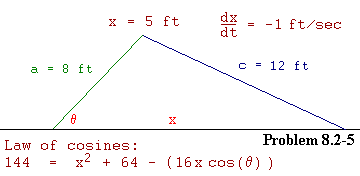

The problem was: Two sticks, one 8 feet long, the other 12 feet long, are joined end-to-end with a hinge. The free end of the 8 foot stick is fixed to the ground. The free end of the 12 foot stick is slid along the ground toward the free end of the 8 foot stick at one foot per second. The whole assembly is held so that the triangle formed by the two sticks and the ground is always perpendicular to the ground. At what rate is the angle between the 8 foot stick and the ground increasing when the distance between the free ends of the two sticks is 5 feet?
The hint was to use the

The first thing to do here is make a diagram. Here's mine. If you made a diagram, you probably got something like this, but you probably didn't do it in color. Here the 8 foot stick is shown in green, the 12 foot stick in blue. The distance between the far ends of the stick (that is along the ground) is x. The angle the problem talks about is q. Again the diagram is not drawn to scale, and your diagram need not be drawn to scale either in order for it to be useful in tackling this problem. Besides, without the aid of a compass, it would be hard to draw this one to scale because we do not yet know the value of q.
Answer to question 1 again is that time, t, is the independent variable. And to question 2, clearly x and q are the dependent variables. And to question 3, there are no hidden variables.
And now to question 4 -- what is
the relationship between x and
q? This is given by
the
c2 = x2 + a2 - (2ax cos(q) ) eq. p5.1a
or in numbers, as is shown in the diagram:
144 = x2 + 64 - (16x cos(q) ) eq. p5.1b
Now comes question 5, and things get just
a little dicey. You do have to use the
dx dq dx
0 = 2x
The problem asks for dq/dt, so
in answering question 6, you need to
figure out a way to solve for that based upon what the problem
gives us, which is a value for x and a value for
dx/dt. The difficulty, of course, is that your solution
must involve cos(q) and
sin(q). But using the
law of cosines equation
+ 2ax sin(q) - 2a cos(q) eq. p5.2
dt dt dt
c2 = x2 + a2 - (2ax cos(q) ) eq. p5.1a
x2 + a2 - c2
cos(q) =
and from that you can readily find sin(q)
using the identity:
eq. p5.3
2ax
___________
|sin(q)| = Ö1 - cos2(q) eq. p5.4
Since q can be no more than
p radians (180 degrees), we are guaranteed
that sin(q) will be positive, and so we
can drop the absolute value in the above.
When you solve
dq 2a cos(q) - 2x dx
Finally to question 7 -- putting in the numbers.
The problem gives us that = eq. p5.5
dt 2ax sin(q) dt
dqNote that the rate is positive, so q is increasing. Does that seem reasonable if x is decreasing? Refer back to the diagram.= 0.361478445 radians/second = 20.71118932 degrees/second dt
Note also that starting with equation p5.1b you could have carried numerical
values down into the subsequent equations instead of the symbols, a and
c. If you made no mistakes you would have ended up with the same
answer. In general, though, it is not a good idea to do this. If you carry
the symbols down, reaching a fully symbolic solution right up until the
last steps (e.g., equation p5.5), not only are you immune to a greate
many arithmetic
mistakes you might have made otherwise, but you also have an opportunity to do
email me at hahn@netsrq.com